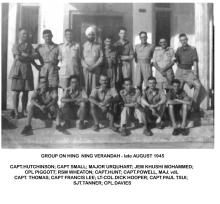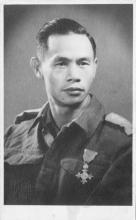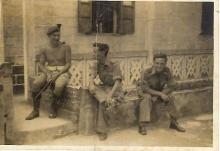Notes about Paul Tsui from his son, Lawrence Tsui:
My father, Paul Ka-cheung Tsui, was a fresh grad of HKU when the Japanese invaded HK. He was recruited by Col. (later Sir) Lindsay Ride and joined the BAAG at Kukong (Shaoguan today) in March 1942 at its inception. He became its civilian Secretary, but was assigned to set up the Field Intelligence Group (FIGS) unit at Wai Chow (Huizhou) in June 1942, controlling agents sent into Hong Kong. In July 1942, J.D. Clague & former SOE Operatives including: Ronald Holmes, Colin McEwan & others forming the Field Operations Group (FOGS) arrived at Wai Chow to form the Advance Headquarters of the BAAG. Paul Tsui also played Liaison Officer with the local Nationalist Chinese authorities. He received a commendation from the Commander-in-chief India in 1943, awarded MBE in November 1944 and received the commission as Captain / Intelligence Officer / GHQ India, towards the end of the War in 1945. His war service led to a brilliant career in the public service of Hong Kong after the War.
After the War, he became Assistant District Officer - South under the British Military Administration. At demob, he became the first local ethnic Chinese Cadet Officer of HM Overseas Civil Service and an Administrative Officer of the HK Government. He remained the top local AO throughout his career, receiving an OBE in 1968 & a CBE in 1973 when he retired.
You can also read Paul Tsui's memoirs online.



Comments
Photos of Paul Tsui
Click a Thumbnail to see larger photo:
Paul Tsui's memoirs, and years of birth and death
Mr. Paul K.-C. Tsui was born in 1916 and, according to Wikipedia, passed away in 1994. Unfortunately some Chinese characters became symbols on the online version of Mr. Tsui's memoirs.
Paul K.C. Tsui
I can provide the Chinese characters since I've the original hardcopies (or a version of what has been uploaded). I've yet to find the time & patience to work at it.
Harold Ingrams devoted quite a few pages in his book 'Hong Kong' Corona Library (1952) on Paul Tsui & Shek Lo.
Here's more on the story of this 2nd generation HK Boy:
Paul Tsui came 5th in a large family of 27 off-springs of Peter Tsui Yan-sau, founder of the Wah Yan Colleges which have been operated by the Jesuits since 1932 & 1946 respectively. He became 'the eldest son' because he had two elder sisters, an elder brother who died young, and the 4th, Philip Tsui Chun-cheung, died in North Borneo. Philip died on his way home from Japanese detention upon Liberation. He was detained & tortured for involvement in local resistance guerrilla movements (according to a monument at Kota Kinabalu).
In fact, the 8th son of Peter Tsui, Stephen Tsui Sai-cheung, was also detained & tortured by the Japanese in HK between January & May 1945 for suspected support to the BAAG. He survived to testify against his tormentors at the War Crime Tribunals (see website on HKU War Crime Tribunal by Dr. Suzannah Linton). He is still living happily in HK.
Indeed, four of Peter Tsui's off-springs worked for the BAAG - Paul, Mark Shing-cheung, Mathew Man-cheung were involved with BAAG intelligence activities in Wai Chow, while Mary Mui-ying was a nurse of the BAAG which ran hospitals & medical posts.
The War was the best of time in the worst of time for Paul Tsui. Upon graduating from Wah Yan, Paul went to Rabaul, New Guinea, to serve as a Lay Catechist in the Overseas Chinese community. He returned HK when there was a major volcanic eruption. He entered the Canton University before going to HKU. With the war looming large, the price of rubber shot up; hence, as owner of a rubber plantation in N. Borneo, Peter Tsui was able to send two of his sons to HKU - Paul & Mark. At HKU, Paul became Chairman of May Hall. In his final year, the Japanese invaded - he got his War Time Degree without having to sit the final examination.
During the mobilisation in preparation of the invasion, Paul signed up to the Auxillary Fire Service because few HKU students were keen. He was made an Assistant Fire Officer (without training). During the invasion, he was assigned a team, a pump & a taxi (to tow it), and took up position at a garage at the Mid-levels. No bomb fell on his precinct. After the War, he was a bit embarassed to receive the Defence Medal for his fire service.
Paul Tsui found his first real job in Kukong serving as Civilian Secretary of the nascent BAAG. It was a relatively well-paid job. His language ability (English, Chinese - Cantonese, Hakka, Mandarin) as well as his thorough knowledge of the geography of HK, being a country boy attending school in urban HK, must have been important considerations for Col. Ride to engage him.
Whereas many BAAG agents had to go behind enemies' line in HK to operate dangerously, Paul Tsui functioned as an Agent Running Officer at the BAAG Advance HQ in Wai Chow. He was well regarded by his Commanding Officers (according to the commendation letters they wrote on him which I have in my hands, including one a C-in-C Commendation by Gen. Auchinleck GOC India). It was Sir Douglas Clague who recommended the award of MBE for his performance as head of the Chinese civilian staff at AHQ.
Being the civilian Secretary, doing interpretation for Inter-Allied Agencies liaison, Paul Tsui could assume a status amongst senior British & Chinese military officers, despite his lowly position. In recommending Paul Tsui be commissioned a British Captain under the War Establishment of GOC India in 1945, Ride attributed credit to him for the ability of BAAG to continue to function in the E.Guangdong area despite mounting Chinese political animosity as well as American & British MI6 encroachments.
Good liaison work enabled the BAAG to operate through territories held by Chinese forces, pro-government guerrillas as well as Red guerrillas. When a Japanese military aircraft crashed in the Long Kong area, Paul Tsui & Agent Percy Cheng (No. 21) were able to negotiate with the local guerrillas to retrieve a bonanza of intelligence materials from the site - maps, code books, secret airfields, establishment documents, et al, which were personally escorted to Kweilin HQ by Major Colin McEwan for analysis.
Paul Tsui actually got married in the middle of the War in January 1944. The bride, Rose Lin, was a HK refugee girl, who was a student of St. Mary's Cannosian College, Tsimshatsui. She was a daughter of a respected retired Chinese general of the Wai Chow area. Paul social status in the locality was further augmented that assisted his liaison work. (Retired Major-General Lin Yin-hung who participated in the Tung Meng Hui of the 1911 Xinhai Revolution and graduated from the Huangpu Military Academy, was executed in 1954; but his conviction was overturned by the Huidong Court in 1984).
Their wedding at St Joseph's Church, Wai Chow, was attended by top British & Chinese military officials. Major (later Sir) Ronald Holmes gave Paul his only suit; Col. (later Sir) Douglas Clague sent Rose a veil all the way from Ceylon. Lt. Col. Dick Hooper & Holmes drew a HK-style Marriage Certificate freehand in ink from memory; and Hooper signed it as OC AHQ BAAG, so that the marriage would be officially recognised in HK after the War (what optimism!). However, they forgot to include the spaces for the bride & groom to sign. The presiding priest, Fr. Anthony Ma, was so overwhelmed by the congregation that he forgot to ask Rose for her consent. They couldn't find the rings which were in the pocket of another priest, Fr. Leo Chan (who later became a VG of the Hong Kong Diocese in the 60s). Halfway through the banquet in the churchyard, Japanese planes came to bomb Wai Chow and all had to flee to the hills. However, the group photo taken outside the church survived. Paul & Rose have 12 off-springs since. The Rectory of St. Joseph's Church which was used as the safe house for FIGS of BAAG AHQ is still standing intact in Wai Chow today.
Being commisioned a Captain meant that the Japanese surrender was not the end for Paul Tsui. He became a member of the British Military Administration of HK after the War until Demob at the end of 1946. He said the Americans paid more and had lots of resources; but the British took care of their people. The Governor, Sir Mark Young, was so much impressed by Paul Tsui as ADO/South that he asked him to become a Cadet Officer of HMOCS despite the existance of a racial barrier. In fact, when Paul Tsui went to Oxford for his training, Sir Mark Young who had retired, greeted him at the train station.
Paul Tsui was aware he was a very fortunate person who had the best of time during the worst of time. He served for many years in the Royal British Legion (China Branch) to take care of the veterans of the BAAG. As a boy, I was therefore privileged to meet many of the former Chinese agents. How I wish I have started the BAAG research a few years earlier!
A boy from Lung Yeuk Tau (head of the Leaping Dragon) had good fungshui throughout his life. In 1967, Governor Sir David Trench allowed him to act as Secertary for Chinese Affairs, a lofty position in the Administration of the time. The Lefitst Confrontation soon erupted into major Disturbance. He stepped into a very difficult position at a critical time of HK. Labled as 'No. 1 Yellow Skin Running Dog' as well as said to be on the top of the assassination list, for his role in rallying the community behind the government, he nevertheless received wide support from the local community. in fact some former BAAG agents revived their roles on their own initiatives and reported to him current situations. Gary Cheung who is revising his books on the 1967 Disturbance - 'HK's Watershed' showed me a copy of a Top Secret document indicating that Paul Tsui carried on a secret liaison with Ho Yin (father of former CESAR Macao Ho Hau-wah) as a channel of communications when Sino-British relation was at a all time low. Not only did he get an OBE, he also blazed a path for the subsequent localisation of the HK Administrative Service at the top level.
Paul Tsui is mentioned an
Paul Tsui is mentioned an article called "Hong Kong hangs on" in the February 1954 issue of the National Geographic Magazine:
In Yuenlong, chief valley centre, we met Mr Paul Tsui, the District Officer, and saw the town's colourful country market. Specialising in seafood, it looks like a marineland museum. Stalls show exotic fish still gasping, sharks, wriggling eels, giant rays and crabs, cuttlefish, prawns, shrimp, and king-size oysters from nearby Deep Bay.
Shoppers are black-garbed farm women; many wear wide fringed hats that look like old-fashioned lampshades, style of a Chinese people call Hakkas.
Yuenlong is having its face lifted. Choi showed us a plan of the future model town and blocks of new flats and shops are already standing. "It took a long time getting started," he said. "All land titles have to be searched, and they go back many, many years."
Near lordly Tai Mo Shan, Hong Kong's biggest mountain, we had tea and Sunkist oranges in a Buddhist convent and visited a just completed housing settlement for British Army officers and their families.
Even in the countryside Hong Kong's garrison is not much in evidence but it's there – larger than ever. The military keep in the background; for instance, police, not soldiers, man the touchy China border. Here and there one sees a camp, and occasional convoys rumble on the highway. All bridges are reinforced to hold tanks. Canteen ((should probably be "Kam Tin")) Valley has a big new military airfield, and RAF jets streak the sky.
Paul Tsui 徐家祥
Paul Tsui (徐家祥) was born on November 5th, 1916 and passed away on October 11th, 1994.
1950 Article on Paul Tsui
A 1950 article on Mr. Paul Tsui appears here. Scroll to Page 8 of the HK Sunday Herald 2 April 1950.